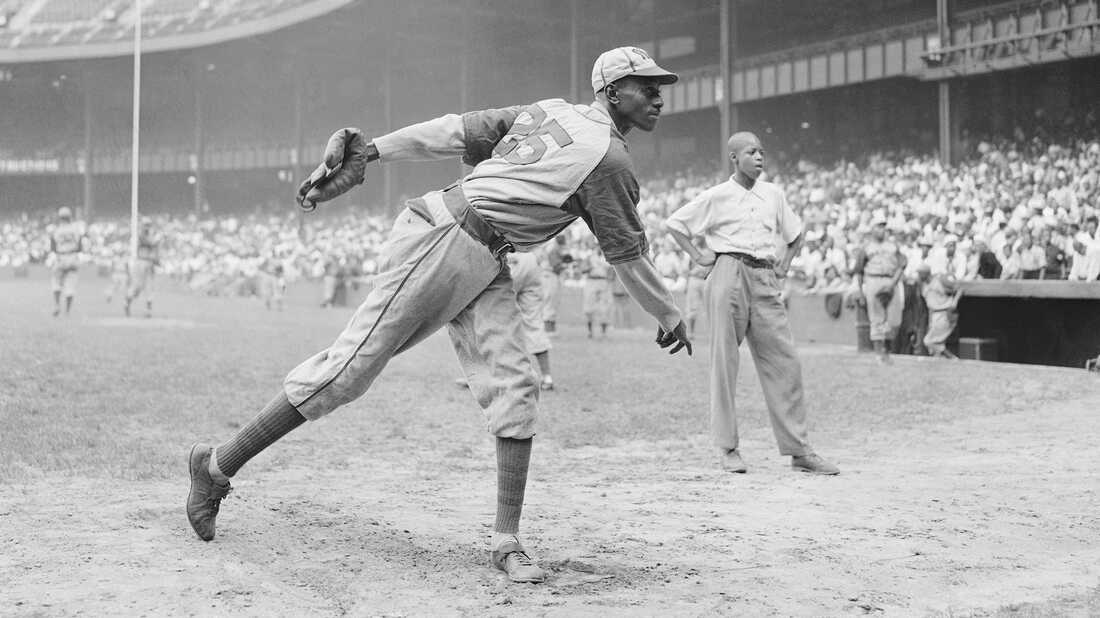
Kansas City Monarchs pitching great Satchel Paige warms up at New York’s Yankee Stadium Aug. 2, 1942 for a Negro League game between the Monarchs and the New York Cuban Stars.
Matty Zimmerman/AP
Matty Zimmerman/AP
This season, the MLB instituted new rules designed to make baseball games shorter and more exciting. According to filmmaker Sam Pollard, some of these changes hearken back to an earlier period in baseball history: The National Negro League.
While sluggers like Babe Ruth dominated MLB, the Negro League, which was founded in 1920, featured a scrappier, hit-and-run, base-stealing style of play. Years later, as the first Black player to play in MLB in the modern era, Jackie Robinson would bring the same energy to a wider audience.
“If you watch footage of Jackie Robinson from the ’40s and the early ’50s, he had a lot of flash and pizzazz,” Pollard says. “You can see it follow up with other players who came along … people like Maury Wills, Willie Mays, Rickey Henderson. They brought a different kind of style, which was part of that style that was in the Negro Leagues. Energetic, punchier, aggressive — a kind of baseball which Major League Baseball is trying to bring back since they’ve changed some of the rules.”
Pollard’s new documentary, The League, tells the story of the Negro League and the way it revolutionized baseball. He describes the league’s games as social events that spawned new businesses and attracted celebrity fans like Lionel Hampton, Lena Horne and Count Basie.
“Even though this [was] a horrific period of American apartheid, this was for the people in the Black community an opportunity to really come out and enjoy themselves,” Pollard says.
Rube Foster, a former pitcher-turned-businessman was the “father of Negro League baseball,” Pollard explains. “[Foster] had a very entrepreneurial spirit and he decided he wanted to put together a league of Negro League baseball teams that would be just like Major League Baseball,” Pollard says. “He brought a bunch of different Black owners together in Kansas City, and they created the Negro National League.”
Interview highlights
On the entrepreneurial spirit behind the creation of the Negro League
Here we are living in the era of Jim Crow and segregation, and African Americans are forced to live within their own communities. And so to survive and to flourish, they created their own businesses. They had their own stores. They had their own funeral parlors, they had their own teams so that economically they could be able to survive. And many of them flourished.
If we look back to the early 20th century, there’s communities like in New York City, Harlem, there’s Chicago, Bronzeville, there’s Black Wall Street in Tulsa, Oklahoma, all these communities basically said, “Well, we can’t integrate. We’ve been forced to be separate. So let’s start our own businesses and economically figure out how to survive.” So the Negro League teams, they were another sense of economic opportunity for Negro League owners and for the patrons to come and pay and see the game. So the money that circulated at these Negro League games, or the money that circulated in these new stores, it all circulated in the Black community, which helped these communities flourish and survive.
On the discrimination Negro League players faced while playing exhibition games against white teams in the South
It was dangerous. Listen, you’re talking about a time when Black people couldn’t go into restaurants. They couldn’t go into bathrooms. Everything was “white” or “colored.” … This was a treacherous period in American history for African Americans. … As Hank Aaron said, they’d have to live on a loaf of bread and some peanut butter, because they couldn’t make it in the restaurant or didn’t have enough money to buy sandwiches. … They would go to some boarding house to sleep and the manager told them, “No, you got to sleep in the field on your suitcases.”
On pitcher Satchel Paige, who became a dominant player in the Negro League in the ’30s
What made this man special was that he had a series of pitches where he could go on the mound and he could strike out a whole team of players in nine innings. He was just a phenomenal pitcher. He was a legend. There’s so much myth surrounding Satchel Paige. For example, there was a story that he would call in the outfield, have them stand behind the infield, have them all sit down, and he would strike out the side of the opposing team. That’s how great he was as a pitcher. …
Even when he was past his prime, he was one of the few African Americans besides Jackie Robinson to be called up into the major leagues by the Cleveland Indians in the late 1940s. So he was a hugely phenomenal player. A legend. People think of Babe Ruth as one of the greatest baseball players of all time, I would say Satchel Paige is equal to that — one of the greatest baseball players of all time.
On what was preventing the integration of Black players into Major League Baseball teams
By the ’30s … white reporters started to come out to the games and they got excited by what they were seeing. And that’s when the discussions really started to escalate about shouldn’t African Americans be integrated into the major leagues? Now the one person that really put the kibosh on that was Kenesaw Mountain Landis, who had become the baseball commissioner after the Black Sox Scandal of 1919. And he was completely opposed to African Americans playing the white players. And he even stopped some of the barnstorming that happened in the ’30s between people like Satchel Paige and Dizzy Dean, who would go out and play around the country, because it was exciting to see two of the greatest pitchers, one white, one Black, play against each other.
On the reaction of Black fans when Jackie Robinson joined the Brooklyn Dodgers in 1947
On the one hand, everybody’s excited. Everybody wanted to see this. A lot of people were excited about the fact that Jackie Robinson was going to integrate Major League Baseball. For me, as a teenager growing up … I thought that was a phenomenal thing that happened in American history. …
It was sort of a major plus in terms of taking African Americans on the road to integration in the sports world. But on the other hand, what was the impact that had on these Negro League teams and Black communities? The teams all of a sudden are losing their best players to Major League Baseball, which made these teams, these Negro League teams, less impactful, not as strong. … Why go and watch Negro League games when you can see some of the best players, who had been Negro League players, now play Major League Baseball? So it had a double-edge impact, which most people never talked about when I was growing up.
On MLB finally recognizing the achievements of Negro League players
In the last 10, 12 years, the Negro Leagues have become much more prominent in Major League Baseball. The fact that now they’ve taken the stats of the major Negro League players and putting them into the Hall of Fame shows that they understand the importance of the Negro Leagues and the many players who came through in the league, some who didn’t get into the Hall of Fame but still were very important players.
Amy Salit and Seth Kelley produced and edited this interview for broadcast. Bridget Bentz, Molly Seavy-Nesper and Beth Novey adapted it for the web.


